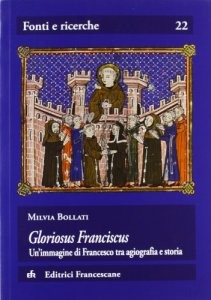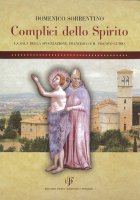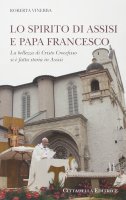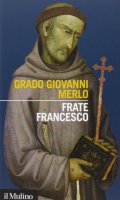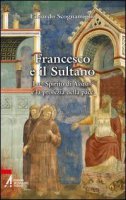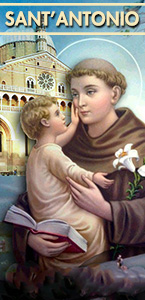Gloriosus Franciscus
(Fonti e ricerche) [Brochure]EAN 9788881350254
The portrayal of Saint Francis in medieval and Renaissance painting is generally associated with narrative, pre-eminently through the great fresco cycle in theUpper Church at Assisi, but also via the later legends painted by Giotto in the BardiChapel, Sassetta on the Sansepolcro polyptych and Benozzo Gozzoli at Montefalco.Milvia Bollati’s important new book presents an alternative history of Saint Francisin early Italian painting, one comprising iconic images of the saint in glory and allegorical scenes of varying complexity.
Although these modes of representation willbe less familiar to non-specialists, Bollati makes a strong case for their centralityto the Order’s conception of its own identity in the later Middle Ages. The cover promises the reader that the book will let the artworks speak through contemporaryFranciscan texts. Some of the images are indeed opaque without the guidance ofFranciscan hagiography and exegesis, a reminder that in most cases we are dealingwith pictures aimed at audiences of friars, not the laity at large. Bollati quotes extensively from written sources, but text does not dominate the argument: indeed,the images themselves emerge as powerful and original formulations of Franciscanthought.
This is especially true of the so-called Vele in the Lower Church, the fourseveries of the crossing vault over Francis’s tomb frescoed by Giotto’s workshop inthe second decade of the Trecento. Bollati’s book marks a significant advance inour understanding of these allegories, arguably the most unjustly neglected masterpieces in early Italian painting.The opening chapter sets the scene in the Lower Church, providing a comprehensive summation of arguments surrounding the first decorative campaign bythe Maestro di San Francesco, usually dated to c. 1260. Considerable attention ispaid to the vestiges of the thirteenth-century scheme that are still visible aroundthe tomb of Philippe de Courtenay in the central bay of the narthex.
Building onthe work of Saskia Esser, Maria Andaloro and Giuseppe Rocchi Coopmans de Yoldi, the author interprets the fragmentary head of a large-scale figure to the right ofthe Courtenay tomb as the tantalising relic of an early representation of Saint Francis in Glory (the reader will benefit from cross-referring to the drawings in the 2002Mirabilia Italiae volumes for Assisi: Saggi, pp. 65-66, figs. 35a-c). Given that only thehead and shoulders of this figure survive (and even this worn fragment is scarcelylegible), its reconstruction must remain hypothetical, but Bollati is surely right tonote that the off-setting of the figure in the narthex bay served to establish an axialrelationship with the saint’s tomb at the opposite end of the nave. In general,though, there is little in thirteenth-century Franciscan art to prepare us for the imagery of Saint Francis in glory that explodes, seemingly fully-formed, onto the crossing vault of the Lower Church at the start of the next century.
The following three chapters, the heart of the book, are dedicated to the Vele:the three allegories of Poverty, Chastity and Obedience and – in the western web facing down the nave – the majestic Saint Francis enthroned with angels. Bollati emphasises the extent to which these frescoes were neglected by scholars in the twentieth century, from the moment Adolfo Venturi denied their attribution to Giotto in1906. The poor regard of modern scholars for the Vele stands in marked contrastto the high estimation of Vasari, who praised their ‘invenzioni capricciose e belle’.Vasari, it may be noted, dedicated much more space in his life of Giotto to the Velethan to the Saint Francis cycle upstairs (partially, one suspects, because he believedthat the Vele and adjacent frescoes were what Lorenzo Ghiberti had in mind whenclaiming that Giotto had painted almost all the ‘parte di sotto’ in the Basilica).Bollati judiciously cautions against seeking the key to the Vele’s meaning in theearly allegorical tract the Sacrum commercium Sancti Francisci cum domina Paupertate, and rejects the tendency to impose a ‘Spiritual’ reading on the frescoes.
In this regard she argues against Elvio Lunghi’s interpretation of the Vele as inspiredby Ubertino da Casale’s Arbor vitae crucifixae (composed in 1305), noting that Ubertino’s condemnations of art and architecture are hard to reconcile with any involvement in such a monumental decorative scheme, especially one executed against aluxuriant gilded background (echoing Cimabue’s golden vault of the Evangelistsabove the high altar of the Upper Church). Bollati also excludes Lunghi’s identification of Ubertino’s sponsor, Cardinal Napoleone Orsini, as the programme’s patron,as well as Martin Gosebruch’s parallel case for Cardinal Jacopo Stefaneschi. Similarpoints have recently been made independently by Julian Gardner, who has characterised the Vele as a corporate commission on the part of the Order, as opposed toany private patron (Giotto and His Publics: Three Paradigms of Patronage, Cambridge, Mass. and London 2011, pp. 83-112). If any prominent personalities were involved, they would have been the senior friars at Assisi: the Provincial Minister andthe Minister General, under whose specific jurisdiction the Basilica lay. Gardner’stext appeared too late to be integrated into Bollati’s analysis, but in fact the twoscholars’ readings of the vault allegories are very close to one another. Both situatethe programme firmly within mainstream Franciscan thought and exegesis.Bollati makes a number of important observations regarding the iconographyof the Vele, for which we still require a comprehensive analysis. Among the morestriking details is the head of the kneeling friar in the Obedience fresco portrayedas a skull in lost profile, which can then be read in light of Francis’s praise, recounted by Celano and Bonaventure, for the perfect obedience of a corpse.
It is perhaps understandable that Jean-Pierre Cottier (‘Le Vele’ nella basilica inferiore di Assisi: Saggio di analisi, Florence 1981) does not feature in Bollati’s bibliography. Cottier’s strange volume is surely the most eccentric publication on the crossingfrescoes (replete with multiple geometric overlays), but the author may have beenthe first to spot the skull in the Obedience allegory (see caption to his figure 14: ‘latesta del frate che prende il giogo pare un cranio’). Turning to the severy of SaintFrancis in glory, we learn that the banner with the cross and seven stars over thesaint’s throne refers to the seven stars held by the Son of Man in Revelations 1.16.This reference echoes the apocalyptic imagery depicted on the ribs of the crossingvault, which establishes an eschatological frame around the four Vele severies. Motifs from Revelations have often been proposed for the lost apse fresco, knownthrough elusive descriptions by the sixteenth-century Franciscan Ludovico da Pietralunga and Vasari, who attributed the conch mural to Stefano Fiorentino. FromPietralunga’s account Bollati convincingly identifies the medallion figures in the border frieze as double personifications of the virtues Prudence, Temperance, Fortitude and Justice, edging our understanding of this lost iconographic puzzle forwards a little further.
This reading is supported by Janet Robson’s analysis in herunpublished doctoral thesis (‘Speculum imperfectionis’: The Image of Judas in latemedieval Italy, University of London 2001, pp. 220-22), who noted that the twoimages of Justice with the scales and the gallows anticipate the double representation of distributive and punitive justice in Ambrogio Lorenzetti’s Allegory of GoodGovernment in the Sienese Palazzo Pubblico of 1338-9. The emphasis on these fourvirtues in the apse of the Lower Church may help to explain their later reappearanceon the Virgin’s throne in Ottaviano Nelli’s 1422 fresco in the Basilica’s narthex.For Bollati, theVele are best understood in the light of core Franciscan texts likeCelano’s and Bonaventure’s lives. The programme’s apocalyptic aspect, rather thanfunctioning as Spiritual polemic, would have been uncontroversial: the identification of Saint Francis as the angel of the sixth seal had been openly asserted in theLegenda maior and the writings of Cardinal Matthew of Acquasparta. At the heartof the crossing scheme lay the belief in Francis’s intercessory powers for his Order,privileges which were founded on the Franciscan Rule and its correct observance.The Vele offered their Franciscan audience a guide to salvation through the exposition of the three vows every friar made to poverty, chastity and obedience. As Bollatiobserves, the frescoes are better understood as visual exempla as opposed to true allegories, and are accompanied by long explicatory inscriptions running below eachsevery.
For the image of ‘Franciscus Gloriosus’ she assembles a comprehensive repertoire of legends relating to the throne reserved for Francis in heaven and visionsof the saint in resplendent purple dalmatics. She convincingly relates the imagery ofthe throne to Francis’s intercessory powers, paralleling the Virgin’s assumption andenthronement. Close examination of the fresco confirms that Francis’s throne is indeed being born aloft by angels, who pull at leather straps attached to the sides ofthe marble seat, while clouds below mark the chair’s heavenly ascent. But theauthor demonstrates that other friars could also attain such heavenly thrones: theMinister General Gonsalvo of Valboa, for example, was envisioned after his death‘gloriosus in throno residens cum sceptro et aurea corona’. For Bollati, the Rulemediated the unique and unrepeatable miracle of Francis’s Stigmata, allowing ordinary friars to imitate their founder and achieve the salvation he promised. It isthis optimistic, intercessory message that underpins Bollati’s reading of the Vele.Seen in this light, the murals on the crossing vault formed part of a broader shiftat Assisi, as the initial thaumaturgical energy of Francis’s cult was overtaken by penitential practices of pilgrimage and devotion focused on indulgences and intercession for souls in purgatory.In chapter 5 Bollati turns to iconographies of Saint Francis in glory that developed in the wake of theVele programme, in particular the theme of Francis standingover the world (symbolized as various kinds of mappamondo disc) and often combined with personifications of the monastic virtues distilled from the Lower Churchallegories. Building on her discovery of a Bolognese manuscript illumination withthis iconography, the author demonstrates its wide dissemination across Italy bythe early fifteenth century. She shows how similar imagery was appropriated forthe cult of San Bernardino, sometimes with three mitres standing in for the worlddisc (shorthand for the three bishoprics rejected by the Sienese saint), and was alsoused by the Dominicans in representations of their founder, Saint Dominic. Onecould add the fifteenth-century application of the mappamondo scheme with themonastic virtues and vices (or variants thereof) to the Augustinian Saint Nicholasof Tolentino, to Saint Augustine himself, and to Saint Benedict in one case from anOlivetan context (National Art Library, Victoria and Albert Museum, London, ReidMS 82, fol. 28v).
By the Quattrocento its currency evidently extended far beyond theconfines of the Franciscan Order.Unsurprisingly, Sassetta’s great polyptych for the Franciscans in Sansepolcro(1437-44) occupies a central place in this chapter. The list of superlatives associatedwith the Sansepolcro polyptych bears repeating: it is the most complex, the most expensive, and now certainly the most fully documented altarpiece commissionknown for the Quattrocento. Scholarship on the polyptych has accelerated in recentyears and further contributions have appeared since the publication of Bollati’sbook (in particular Andrea De Marchi’s important review article in «Prospettiva»,139-140, July-October 2010, but published June 2012, pp. 115-30). Bollati gives dueconsideration to arguments made by the present reviewer and other scholars for theexistence of a significant precedent for Sassetta’s altarpiece in the guise of a lostdouble-sided polyptych painted by Spinello Aretino for the Franciscan church inthe neighbouring Umbrian town of Citta` di Castello in the years around 1400. Onlyone fragment of Spinello’s altarpiece seems to survive, the Confirmation of the Rulenow in the Art Institute, Chicago.
The major disagreement in the recent literaturerevolves around how to interpret the instruction that Sassetta received in 1439 topaint the central Saint Francis for the Sansepolcro polyptych ‘in uno trono comoquello di [Citta` di] Castello con quelle vertu` da capo et i vitii da piey’. If the image referred to in Citta` di Castello was part of an earlier double-sided polyptych, does the1439 document imply that Sassetta’s astonishing imagery of Saint Francis with thevirtues above and vices below derived from an older altarpiece, in all likelihoodpainted by Spinello Aretino over thirty years before? Or should one read ‘in uno trono’ narrowly to reconstruct the lost image at Citta` di Castello as a Saint Francisseated on a physical throne in the style of theVele ‘Franciscus Gloriosus’, rather thanstanding within a mandorla? In which case, Sassetta’s iconographic scheme maystill be seen as the Sienese artist’s personal achievement (possibly guided by SanBernardino).
Bollati comes down on latter side of the argument, and makes somenew observations regarding the iconography of the Sansepolcro polyptych. AligningSassetta’s central Saint Francis in Glory with her preceding analysis of the Vele frescoes, the author argues that it can be read as a ‘triumph of the Rule’. The introduction of a mandorla at Sansepolcro further emphasises the importance of the monastic vows and can be linked to the omission of the Confirmation of the Rule from thesurrounding narrative cycle (where it was replaced by the Granting of the Porziuncola Indulgence). For Bollati, the central figure of Saint Francis, by integrating themonastic vows within the Saint’s glory, effectively replaces the conventional portrayal of the Confirmation of the Rule, and explains the absence of this canonicalscene from the altarpiece’s narrative cycle. Scholars will need to consider this newinterpretation, particular in relation to the written instructions issued to Sassettain 1439 by his Franciscan patrons (the so-called scripta).
The Granting of the Porziuncola Indulgence scene was already envisaged by this document, at the same timeas it specified the ‘in uno trono’ iconography for the central image.At the dawn of modern scholarship on Franciscan art, Henry Thode gave allegory an equal status to narrative in his account of the Order’s early artistic patronage. Bollati’s book finally restores the Vele and their iconographic progeny to theheart of our understanding of Franciscan visual culture. This review cannot do justice to the wealth of reading that the author deploys to unlock the richly texturedmeanings that stand behind these images. More than ever before, the Vele – painted by Giotto’s assistants, but surely planned in detail by the master himself – demandto be reassessed as the Order’s crowning artistic statement of identity and ideologyfrom the later Middle Ages.
Tratto dalla Rivista "Il Santo. Rivista francescana di storia dottrina arte" LII, 2012, fasc. 3
(http://www.centrostudiantoniani.it)


